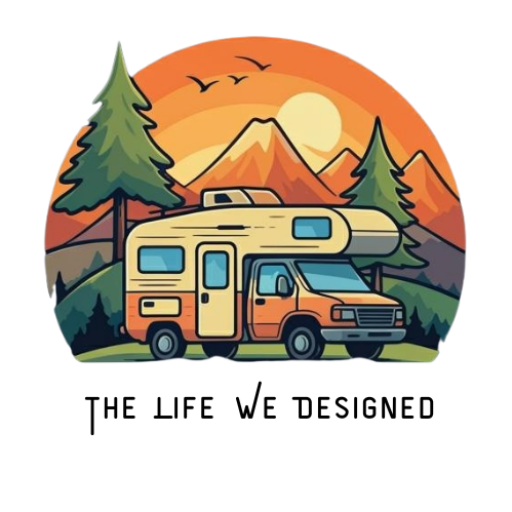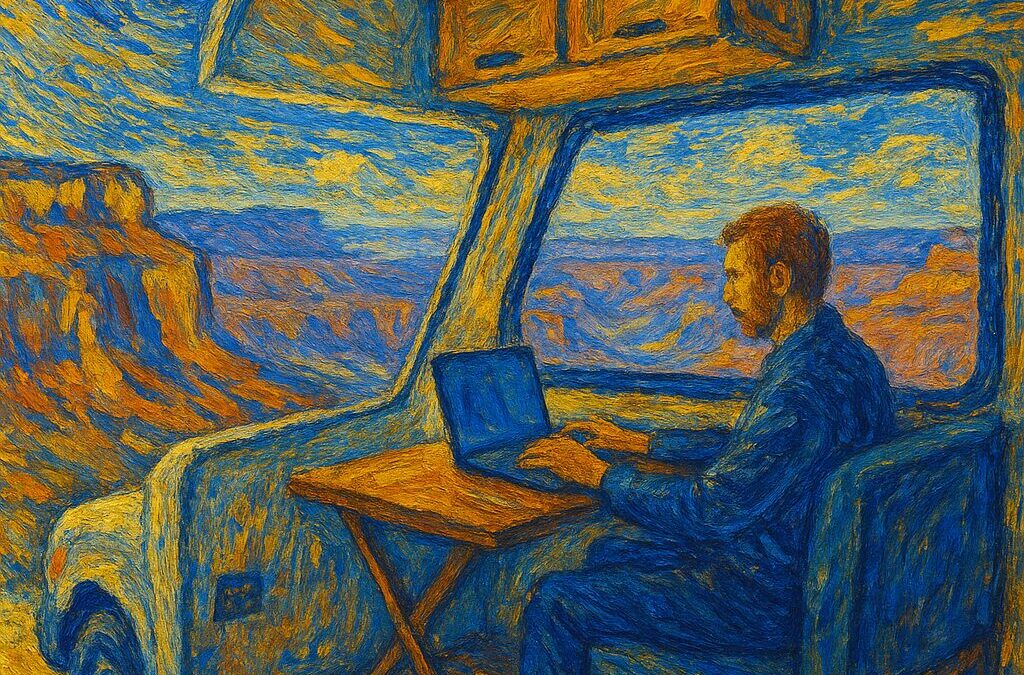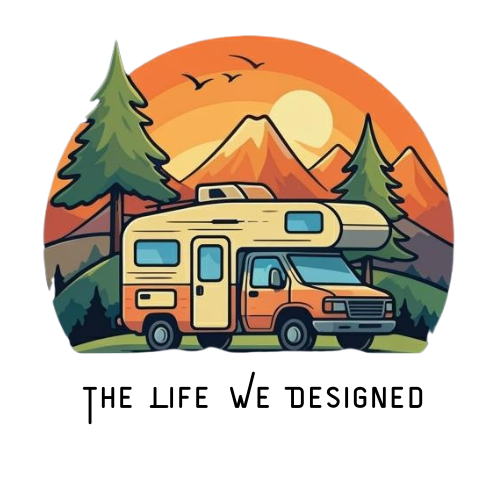Picture this: Your morning commute is a short walk from your bedroom to your dinette, with a view of the Grand Canyon out your window. Your office? It changes weekly – sometimes it’s beachfront, sometimes it’s nestled in a forest. This isn’t a vacation fantasy; it’s the reality for a growing community of remote workers who’ve transformed their RVs into sustainable mobile offices.
Three years ago, Mia made this leap, trading her Seattle tech office for a solar-powered workspace on wheels. “What I discovered wasn’t just a new way to work, but a whole new approach to living.”
With remote work becoming increasingly mainstream (47% increase since 2020), there’s never been a better time to combine professional ambitions with sustainable travel dreams.
In this guide, we’ll walk through exactly how to create an eco-conscious mobile office that keeps both your career and the planet thriving.
Contents
SETTING UP YOUR MOBILE OFFICE
Let’s start with the foundation of your success: creating a workspace that’s both productive and planet-friendly. Here’s the truth nobody tells you – you don’t need to sacrifice professional efficiency for environmental consciousness. In fact, they work beautifully together.
Power Management: Your Green Foundation
The heart of your eco-friendly office starts with the power source. Living truly free sometimes means going off grid. This is where solar power shines.
Your solar setup doesn’t need to be complicated, but it does need to be intentional. Start with 200 watts of solar for basic work needs, scaling up if you’re running multiple monitors or heavy-duty equipment. Pair this with a quality battery bank – lithium is more expensive upfront but more efficient long-term. (Greener options are just coming online so keep your eyes open.)
Creating Your Workspace
Gone are the days of balancing your laptop on a pillow (trust me, your back will thank you). Consider a collapsible desk that tucks away when not in use. You may like what Mason has set up in his class C motorhome:
- A wall-mounted folding desk (saves precious floor space)
- Ergonomic chair that doubles as outdoor seating
- LED task lighting powered by solar
- Multi-use storage solutions that keep everything secure while driving
The Internet Question
Here’s where things get interesting. While cellular data is your friend, it is not always available.
We stayed near Yosemite for five months last summer without cell service. The only available Wi-Fi was at the RV park office – outside – and it was 100° F for weeks.
You may not think about how much your internet use contributes to CO2 emissions. Anything that uses energy has a large footprint because our energy is still largely generated by dirty fuel. But we can discuss that issue a bit later in another article.
Consider these options:
- Downloading work materials during high-signal areas
- Using offline modes when possible
- Setting up a signal booster to maximize existing connections rather than relying on multiple devices
- Creating designated offline work periods
Pro Tip: Schedule heavy internet usage (video calls, large file transfers) for times when you’re using campground power or public Wi-Fi (with a good VPN of course), saving your solar-stored energy for lighter tasks.
BALANCING WORK AND TRAVEL
Remember the fantasy of working from anywhere? Well, “anywhere” comes with its own unique challenges. After sending an important client email at 3 AM because I forgot about time zone changes, I learned to get strategic about blending movement with deadlines.
The Sweet Spot Schedule
Think of your travel schedule like a tide – there’s a natural rhythm to it. I’ve found that monthly stays work best: one week to settle in, two weeks of peak productivity, and one week to explore while wrapping up projects. It is also a huge cost savings if you are staying in a campground or RV park.
This pattern not only maintains your professional momentum but also reduces your environmental impact through less frequent movement.
Time Zone Mastery
I don’t know how many times I have messed up due to crossing time zones. My Google calendar was not always set to the right zone, or the right time. In some cases, I was not sure what zone I was in, especially in Arizona. Thank goodness for Siri.
When you’re crossing time zones while managing team meetings, try this approach:
- Stay in one time zone for project-heavy months
- Schedule movement during lighter work periods
- Use your website’s time zone to anchor your schedule
- Build buffer days around big transitions
Environmental Impact Planning
Here’s something most digital nomads don’t talk about: your movement patterns affect more than your work schedule.
I am in the wrong spot now, sitting in the beautiful red rocks of southern Utah – but it’s June. This means the air conditioner needs to run about 20 hours a day.
This is not only an energy suck, but it is very noisy when I am trying to join in on a Zoom call.
High Season Strategy
- Work from less popular destinations during peak seasons, but that could mean the temps are not ideal.
- Take advantage of shoulder season rates and reduced crowd impact
- Use this time to explore overlooked locations that need tourism dollars
Movement Minimization
Rather than jumping between locations, try the hub-and-spoke method. Park in one central location for workdays, using your tow vehicle or bike for shorter exploration trips. This approach cuts down on fuel consumption while maximizing your ability to discover an area deeply.
We currently have a Class C motorhome which has relatively low miles, and a tiny car that gets 38 mpg. We had an electric car when we started on this current journey in 2019, but it did not have enough range to do much exploration. When this car wears out, we will look for a high range EV. But for now, this one is doing great.
TECH ESSENTIALS AND ECO-FRIENDLY ALTERNATIVES
Let’s talk about tech – but with a green twist.
After several years of trial and error, I’ve discovered that the most sustainable tech setup is often the simplest. No need for every gadget promising to revolutionize your mobile office.
Core Equipment That Makes Sense
Think of your tech like a capsule wardrobe – everything should serve multiple purposes:
• Energy-efficient laptop (look for 12-hour+ battery life)
• Portable second monitor with USB-C power (runs directly from laptop)
• Phone that doubles as hotspot and backup webcam
• Bluetooth keyboard/mouse combo to reduce battery waste
Power-Smart Practices
You know what’s better than buying new eco-friendly gear? Using what you have more efficiently. Here’s what works:
Morning: Use natural light and battery power while your solar panels are warming up
Midday: Run power-hungry tasks when solar input is highest
Evening: Switch to low-power tasks and offline work
I also utilize power strips surge protectors that I can power off when not working. This takes care of phantom power use.
Digital Declutter for Sustainability
We don’t often think about digital waste, but every file stored consumes server energy somewhere. Monthly digital cleanups aren’t just good organization – they’re considered taking environmental action:
- Delete unnecessary cloud files
- Clear email archives
- Optimize photo storage
- Use offline document versions when possible
SUSTAINABLE BOONDOCKING FOR REMOTE WORKERS
Think of boondocking as your ultimate work-life-sustainability trifecta. After discovering I could run my entire business off-grid, everything changed. The secret? It’s not about deprivation – it’s about smart resource allocation – and solitude of course.
The Perfect Workday Off-Grid
Morning ritual: Begin work early when solar power is building. Your device batteries are fully charged from yesterday, and your energy needs are minimal. This is your power sweet spot for video calls and intensive computer work.
Mid-day magic: By 10 AM, your solar panels are doing their best work. Time to charge everything – backup batteries, devices, and even that portable coffee maker you can’t live without.
Afternoon strategy: As power generation peaks, run any high-draw activities. Need to download large files? This is your moment.
Resource Management Like A Pro
Water conservation becomes second nature when you’re working off-grid. The smaller your rig, the less water storage you have available. For some it can become a game to see how many days they can go without a shower. This is not ideal for me. But here are some tips to get you through a few days in remote locations.
- Use a spray bottle for dishes between deep cleans
- Install a navy shower head with pause button
- Keep a dedicated work-day water bottle
- Master the art of single-pan meals
Location Intelligence
The best boondocking spots for remote workers aren’t always the most Instagram-worthy. Sometimes the location is not ideal but there are ways to make them better.
Look for:
• Higher elevation in summer (less A/C needed)
• Natural wind corridors for cooling
• Tree cover for shade without blocking solar
• Clear cell signal zones (less power needed for boosting)
• Proximity to fresh water sources for easier refill options
BUILDING COMMUNITY ON THE ROAD
The biggest myth about remote work in an RV? That it’s lonely.
Truth is, it’s possible to find more meaningful connections while on the road than working in a suburban office job. The key? Being intentional about community while honoring our collective commitment to sustainable travel.
Digital Nomad Tribes
“Finding your people starts online but blossoms in real life,” says Noah, “Some of my closest friends started as usernames in digital nomad groups. We now coordinate our routes to meet up at eco-friendly campgrounds and organize group boondocking sessions where we share resources.”
Resource Pooling That Makes Sense
When you find your crew, magic happens, not only around the campfire after hours, but from the added benefits of understanding each other’s’ lifestyle. Some of those benefits include:
- Shared mobile hotspots during work hours or Starlink connections
- Community solar charging stations
- Group grocery runs to reduce individual trips
- Skill-sharing sessions (think tech services, RV services, cooking, and more)
- Exchange unused items or gear
- Coordinating library-style book or gear lending among group members
Creating Sustainable Meetups
Reimagine the traditional happy hour. Instead of everyone running their own generator, try community-style workdays:
- Morning group work sessions using one power source
- Shared meal prep to minimize cooking fuel
- Collaborative cleanup efforts at boondocking sites
This isn’t just about finding friends – it’s about building a movement. Together, we’re proving that remote work, community, and environmental consciousness can coexist beautifully.
PRACTICAL MONEY-SAVING ECO TIPS
When Sarah first started her remote work journey, she thought being eco-conscious would drain her savings. Two years later, she shared with our community that her monthly expenses had dropped by 40% – all while reducing her carbon footprint.
The magic happens in the details. Take Janet and Mike, who transformed their RV’s energy usage with simple changes. They installed thermal curtains and created distinct temperature zones in their rig. Now their workspace stays cool during work hours while the living area adjusts naturally with the day’s temperature. Their power consumption dropped dramatically, and their comfort level actually improved.
Resource management becomes second nature on the road. One nomad family discovered that batch cooking during cooler morning hours not only saved power but also gave them more family time during the week. They prep meals while their computers charge, multitasking their energy usage.
The shopping revolution happens naturally too. You’ll find yourself planning routes around farmer’s markets, discovering local food co-ops, and sharing resources with fellow travelers.
Long-term nomads often joke that their wallets got fatter while their carbon footprint got smaller.
The secret isn’t in grand gestures – it’s in the daily choices that benefit both your bottom line and the planet. As the saying goes in our community:
“The greenest choice is usually the most affordable one.”
CONCLUSION
Picture this: Your morning video call from beside a mountain stream. Your afternoon reports are finished while watching dolphins play in the surf. Your evening spent sharing travel tips with newfound friends around a solar-powered campsite. This isn’t a daydream – it’s the reality countless remote workers are creating right now.
Making the leap from traditional office to eco-conscious nomad doesn’t happen overnight. It unfolds in small, intentional steps. Each decision – from how you power your laptop to where you park your home – builds upon the last. Together, these choices create not just a sustainable lifestyle, but a whole new way of seeing the world.
The community of conscious digital nomads grows stronger every day. We’re proving that success doesn’t require sacrificing our planet, and freedom doesn’t mean leaving our professional ambitions behind. Your desk is waiting, wherever you choose to park it.
Ready to join us on the road?



